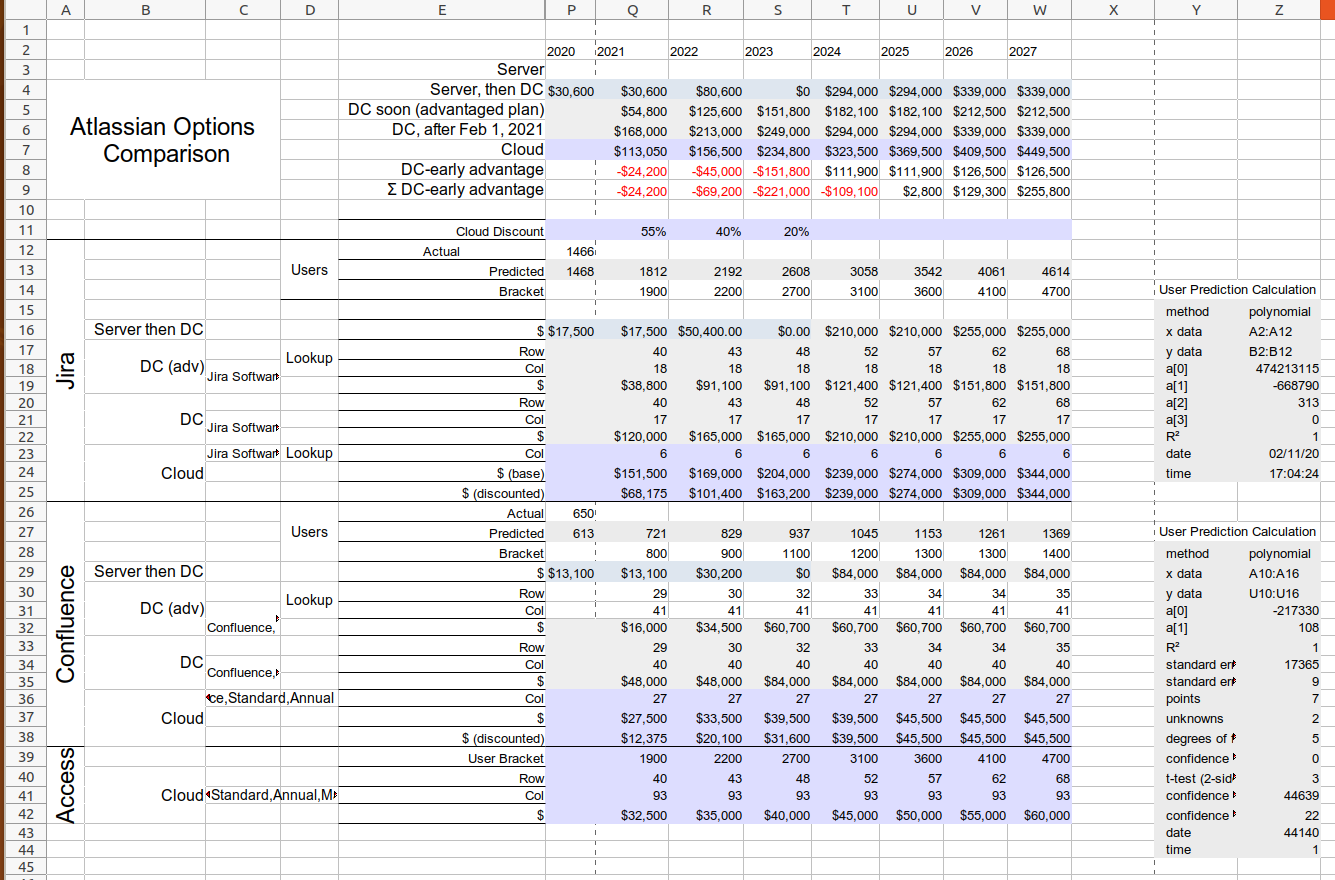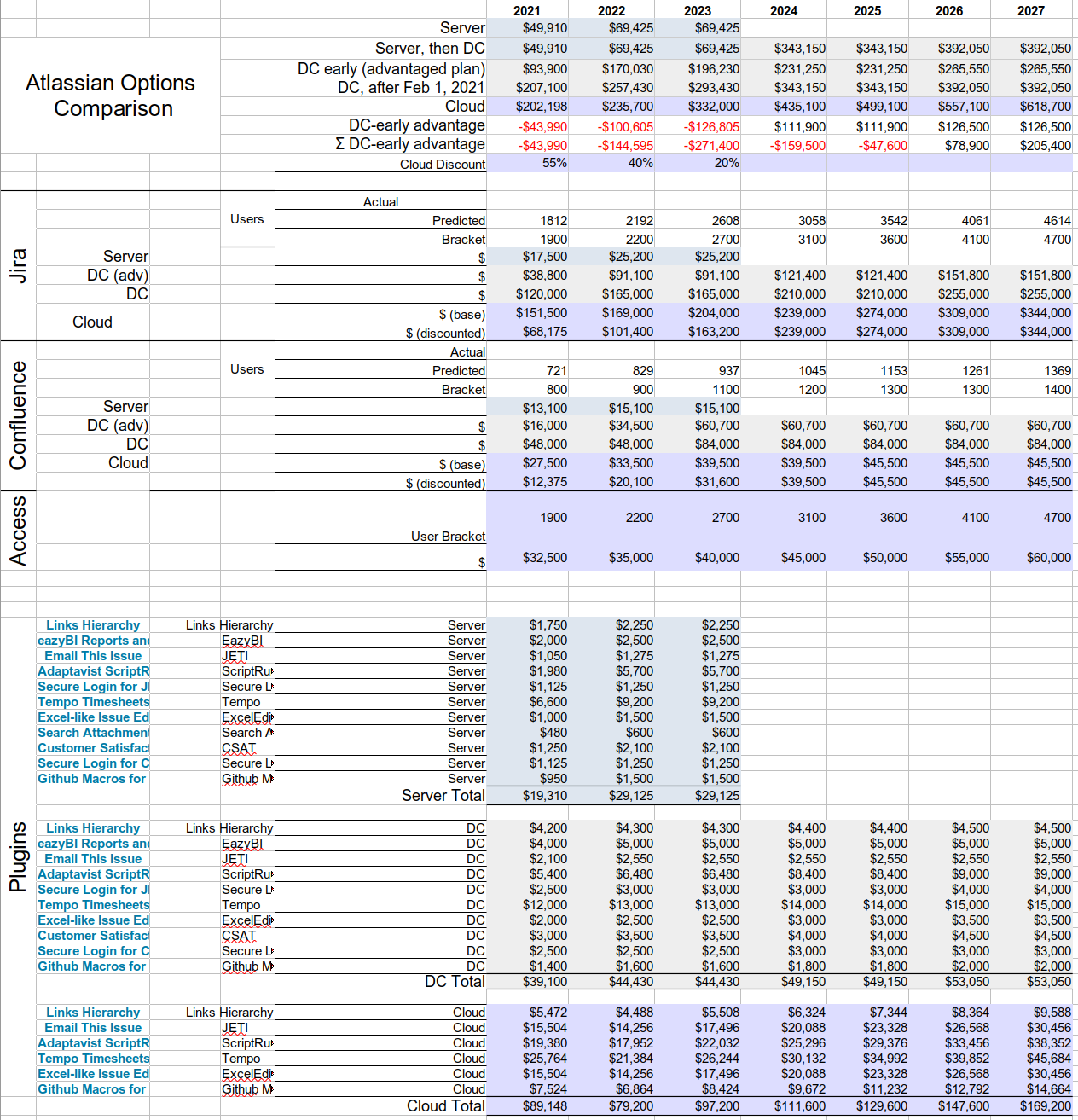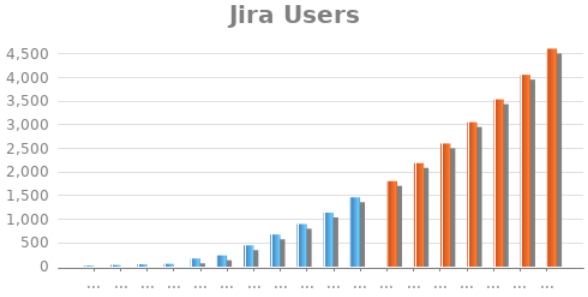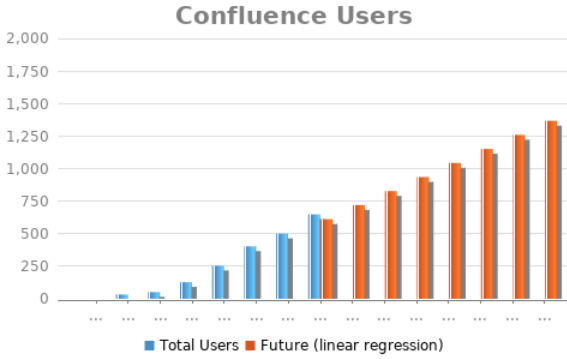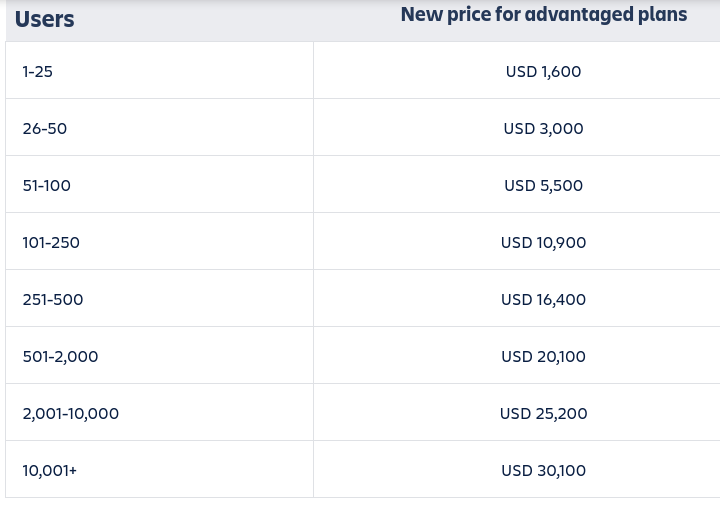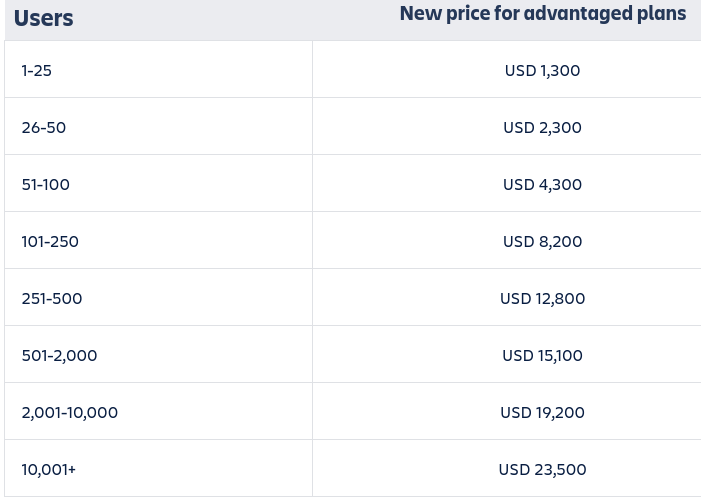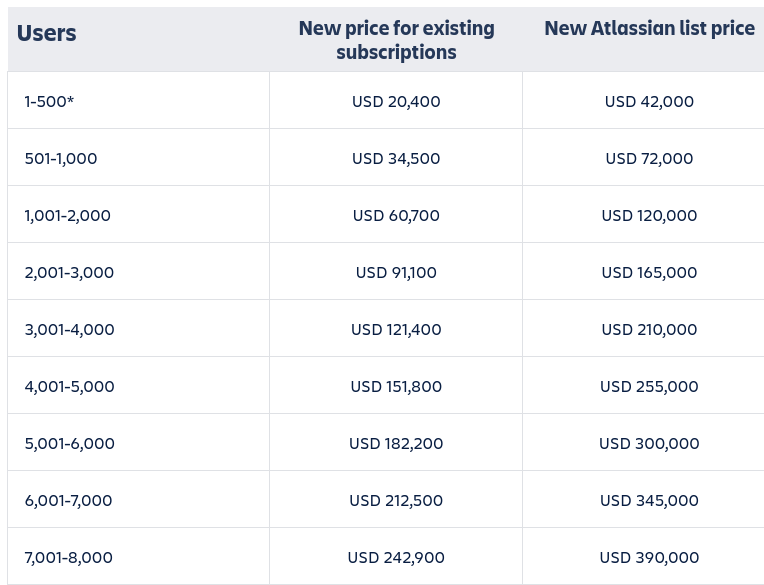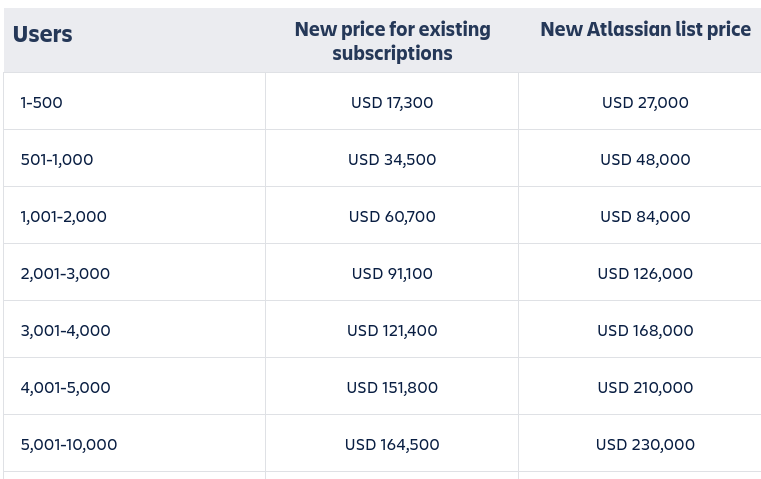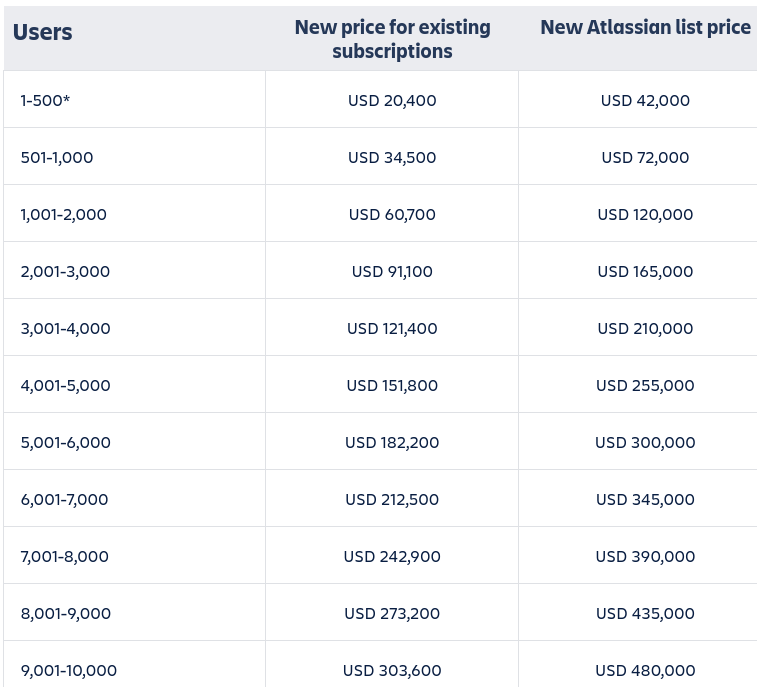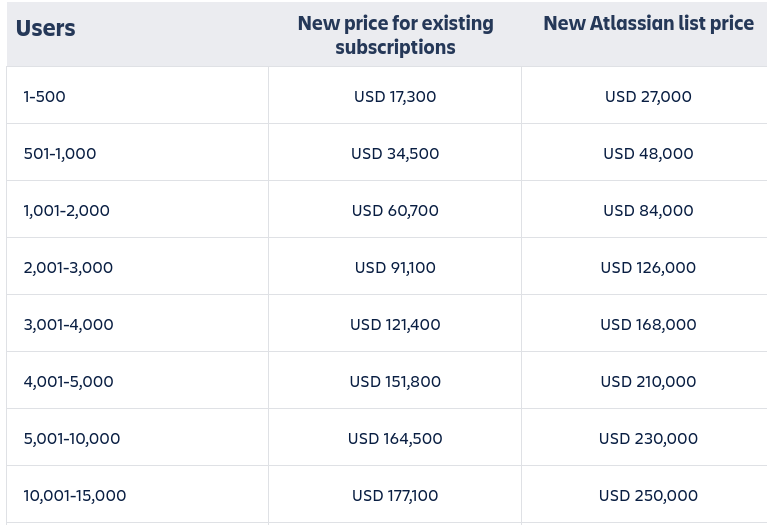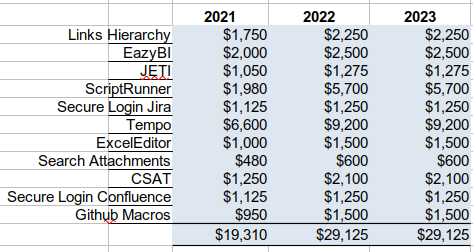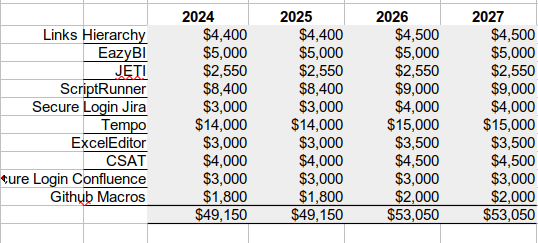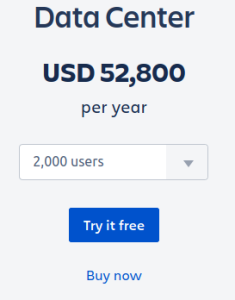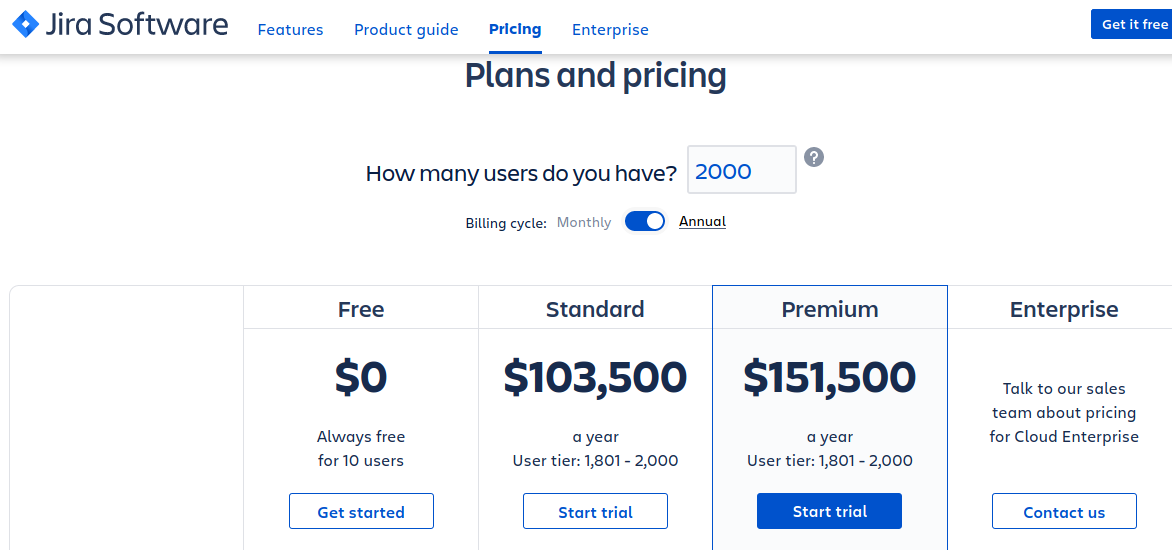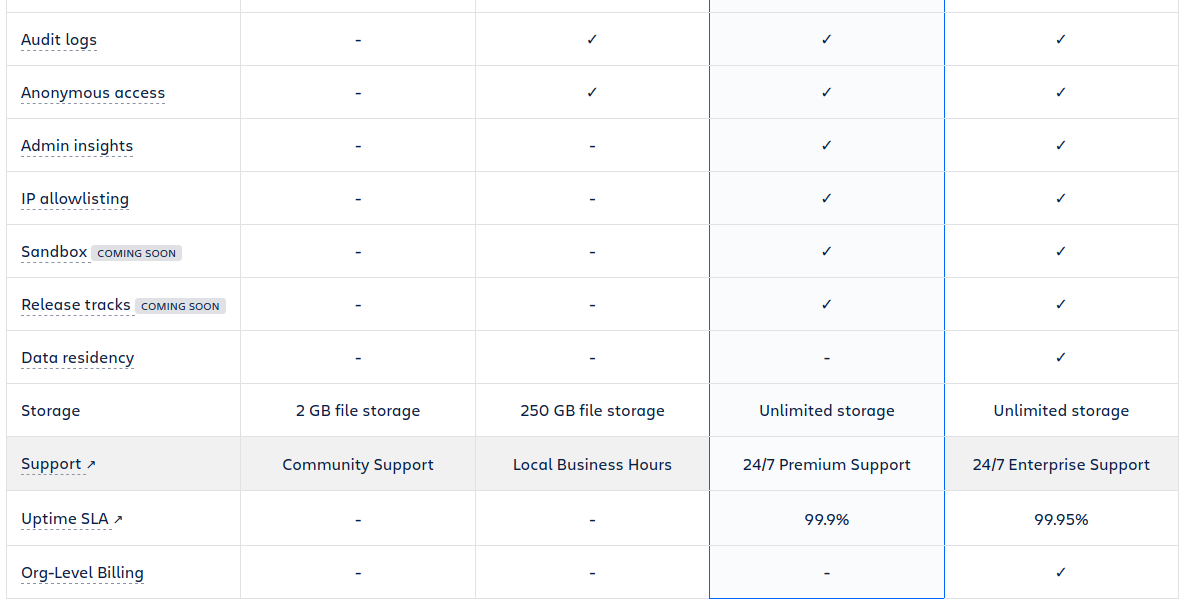...
Atlassian is pushing the majority of customers to Cloud. The 'Data Center' (DC) product line, a clustered edition for large instances, will still be available, but its price will be increasing by 15-180%.
| Anchor | ||||
|---|---|---|---|---|
|
Current/Past Pricing (2020)
...
In 2020 we paid about $49,910 in licensing fees:
- $17,500
...
- to renew Jira's 2000 user license.
...
- $13,100
...
- to renew Confluence's 2000 user license.
- $19,310 to renew various plugins, notably Tempo, EazyBI and ScriptRunner.
Both these These prices were artificially low, as we are on an 'advantaged' (grandfathered) plan that escaped the 2019 price increases.
Plugins are not considered here as their costs are dwarfed by the base costs, but increases moving to Cloud can be assumed (e.g. 20% for Tempo Timesheets, 600% for JETI).
Summary: Future Pricing
The three options Atlassian make available to us are:
Summary: Future Pricing
The three options Atlassian make available to us are:
- Stay with Server as long as possible, then migrate to DC (option 1).
- Migrate to DC soon to get ourselves a 'advantaged' (grandfathered) license (option 2).
- Migrate to Cloud (option 3). Cloud may not be possible for us due to GDPR compliance and lack of certain plugins. See discussion below.
Here are the anticipated prices for each option, taking into account projected user count growth and various short-term discounts. There are two DC columns rows because the price for DC will be different (for a while) if we act before Feb 1, 2021 and get on a 'grandfathered' / advantaged plan to escape the 15-180% price hike coming then.
We are in for an 8x-13x price increase over the next 6 years Our base spend (Jira + Confluence) will thus increase 10x or 11x from its current $30,600
Recommendations
The least disruptive move would be to move to Data Center, assuming we can afford it (the 'DC, after Feb 1, 2021' column). Moving early will lock in some discountsget us on the discounted 'advantaged plan' for a while. Just be aware that DC is an annual subscription, not a perpetual license like Server, and that DC won't last forever (see blog post Betting on Atlassian DataCenter?). As happened with Server, DC is likely to undergo constant price increases to 'squeeze' larger customers onto Cloud.
...
This "lock down and wait" approach can be realised in 4 steps:
Step 1: Pay Atlassian one more time for upgrading Jira's 2,000 user license to 10,000 users
One more upgrade buys us license slot headroom beyond 2022:
Do not pay for further Server renewals. Atlassian haven't added any serious feature improvements in years, and certainly won't do so now. Bug fixes are nice, but after 18 years of development there aren't many bugs left that affect us and that Atlassian are willing to fix. Atlassian support on its own isn't worth paying for.
On the other hand, we do need ongoing security patches if we are to run a public-facing instance. Which is why:
Step 2: Move customer support to an external Cloud-managed system
Implement a new public-facing system for customer support. Perhaps Jira Service Desk (JSD) Cloud where non-agents are free, or ServiceNow.
...
Moving customer support to JSD Cloud means that non-linear growth isn't a problem: we don't pay for customers, only for 'agents'. Moving our customers to a Cloud product should be a net win for security.
Step 3: Lock down Jira to just employees
Jira averages about 1 'critical' security vulnerability every 6 months (generally a CSRF). If we stop paying Atlassian maintenance fees, or run Jira beyond 2024, we need to mitigate security vulnerabilities ourselves, which we can only realistically do by locking down Jira. Either:
...
We could further lock down Jira by adding a WAF like mod_security or Cloudflare, so that security vulnerabilities we learn of can be mitigated at the HTTP layer.
Step 4: Look for alternatives
With customers out of the picture and Jira locked down to employees, we can take our time evaluating Jira Server alternatives.
...
Also, in 5 years time there may be decent competitors. I've been impressed with https://wiki.js.org and xwiki.org as Confluence alternatives. Good Jira alternatives are much scarcer, but there is Youtrack, Gitlab and a host of SaaSes (Asana, Clubhouse). Even Request Tracker is looking less 90s these days and may be an option. I and others will be keeping tabs on alternatives via https://www.goodbyeserver.org/
Future Pricing Calculations
We now show how the numbers above are derived. Note: the primary source of calculations is a spreadsheet, which I unfortunately cannot publish due to containing Partners-only information:
How many users?
Before considering costs, we need to know how many users we expect to cater for in future.
| Jira | Confluence | |||||
|---|---|---|---|---|---|---|
Jira has a 2000 User license, with 1463 license slots used as of . License use is increasing each year (despite automatic deactivation after 6 months' inactivity). This shows that if current growth continues we will hit our 2000-user license limit in early-2022, and will be forced into Jira's next user tier, 10,000 users.
| Confluence is also on a 2000 user license, with 650 license slots used as of . Growth appears linear. No 'deactivate inactive user' process is being run yet. |
| Anchor | ||||
|---|---|---|---|---|
|
Option 1: stick with Server as long as possible, then move to Data Center
2021
We are on 'advantaged' plans, and we know price increases are coming for 'advantaged' plans on 2/Feb/2021.
Jira's natural renewal date would be May 06, July 2021, and Confluence's would be Aug 17, February 2021.
But, but renewing early before the price increase, we can save a bit of money. This is "Option 3: Renew on server early and lock in your existing price".
So prior to Feb 2, 2021 we should:
- Renew Jira till Jul 4, 20212022, for $2$17,600500.
- Renew Confluence till Feb 2022, for $2,000.Renew plugins, for $2,773. $13,100
2022
Jira will be due for renewal in May 2022, and Confluence in Aug 2022.
However! We expect we'll need to upgrade our user tier from 2,000 users to 10,000 in 2022. However, Atlassian plan to stop selling such license upgrades after Feb 2, 2022 and we expect we'll exceed the 50-user tier in this 2022. If we wait till May or August we'll be stuck on the 50-user tier forever.
So once again we must jump in early. Prior to Feb 2, 2022 we must upgrade Jira and Confluence from 50 to 100 users.
"How long can I lock in my current pricing" FAQ in the Billing & licensing questions section of the Future server pricing page, it will to renew for 24 months:
So both our Jira 10,000 user license and Confluence 2,000 user license will last 24 months, from Jan 2022 till Jan 2024.
As for pricing, our 'advantaged' status will have ended on Feb 2, 2021, so the 'New price for advantaged plans' prices from the Future server pricing tables page applies:
...
Confluence
...
...
!
So once again we must jump in early, upgrading our user tier before Feb 2, 2022 so we're not stuck on the 2,000 user tier forever.
As for pricing, our 'advantaged' status will have ended on Feb 2, 2021, so the 'New price for advantaged plans' prices from the Future server pricing tables page applies:
| Jira | Confluence |
|---|---|
The costs in Jan 2022 would thus be:
...
- $25,
...
- 200 for Jira (
...
- annual price for the
...
- 2001-10,000 user tier)
...
- $15,
...
- 100 for Confluence (
...
- annual price for the
...
- 501-2000 user tier)
2023
No costs, as we paid for this year in advance.
2024+
After 2/Feb/2024 all support ends, and we'd have to purchase Data Center licenses annually, at the 'New Atlassian list price' from the future DC pricing tables:
...
...
For Jira this means $210,000+. For Confluence it means $84,000+.
Future Server Summary - 2021-2025+
The total costs of staying with Server as long as possible will be:
...
$50,400
...
$210,000
(assuming 3001-4000 user bracket)
...
$210,000
(assuming 3001-4000 user bracket)
...
$84,000
(assuming 1001-2000 user bracket)
...
$84,000
(assuming 1001-2000 user bracket)
The cost from 2021-2023 is $111,200 (17500+50400+13100+30200) and $294,000 (210000+84000) per year thereafter (while under 4000 users).
...
Option 2: Move to Data Center early (before 2/Feb/2021)
If we upgrade our licenses to Data Center before 2/Feb/2021, then:
- we will get an initial 'crossgrade discount' on the first year (not the 'loyalty discount')
- We get ongoing price reductions that are quite significant - effectively we'll be grandfathered in, and escape the 15% to 180% DC price increases on Feb/2021. Specifically, the N ew price for existing subscriptions column of these tables in the Future Data Center pricing tables page would apply to us for the foreseeable future:
...
...
- For Confluence, we can 'downgrade' our user tier from Server's 2000 to DC's 1000-2000 tier, as we expect to have <1000 users until 2023.
So prices would be:
...
$38,800 ($52,800, the current price of 2000-user DC, less crossgrade discount of $14,000)
...
$91,100
assuming 2000-3000 users
...
$121,400
assuming 3001-4000 users
...
$121,400
assuming 3001-4000 users
...
$151,800
assuming 4001-5000 users
...
$151,800
assuming 4001-5000 users
...
$60,700 assuming 1001-2000 users
...
$60,700
assuming 1001-2000 users
...
$60,700
assuming 1001-2000 users
...
$60,700
assuming 1001-2000 users
...
$60,700
assuming 1001-2000 users
A user tier upgrade resets the maintenance clock, so our 100-user licenses would expire in Jan 2023. We would again pay:
- $25,200 for Jira (annual price for the 2001-10,000 user tier)
- $15,100 for Confluence (annual price for the 501-2000 user tier)
(assuming Atlassian don't increase the prices again – something we might want to protect against by renewing for 24 months in 2022)
Our licenses last right up to Jan 2024, after which Atlassian end all support.
2024+
After 2/Feb/2024 all Server support ends, and we'd have to purchase Data Center licenses annually, at the 'New Atlassian list price' from the future DC pricing tables:
| Jira | Confluence |
|---|---|
For Jira (3100+ user tier) this means $210,000+. For Confluence (1200 user tier) it means $84,000+.
Summary – Server then DC, 2021-2025+
| 2020 | 2021 | 2022 | 2023 | 2024 | 2025 | 2026 | 2027 | |
|---|---|---|---|---|---|---|---|---|
| Jira | $17,500 | $17,500 | $25,200 | $25,200 | $210,000 | $210,000 | $255,000 | $255,000 |
Confluence | $13,100 | $13,100 | $15,100 | $15,100 | $84,000 | $84,000 | $84,000 | $84,000 |
| Total | $30,600 | $30,600 | $40,300 | $40,300 | $294,000 | $294,000 | $339,000 | $339,000 |
Server plugin licensing
Plugin licensing for Server will increase by 50% as we move from the 2,000 to 10,000 user tier, followed by a jump as we move to DC:
| Anchor | ||||
|---|---|---|---|---|
|
Option 2: Move to Data Center early (before 2/Feb/2021)
If we upgrade our licenses to Data Center before 2/Feb/2021, then:
- we will get an initial 'crossgrade discount' on the first year (not the 'loyalty discount')
- We get ongoing price reductions that are quite significant - effectively we'll be grandfathered in, and escape the 15% to 180% DC price increases on Feb/2021. Specifically, the New price for existing subscriptions column of these tables in the Future Data Center pricing tables page would apply to us for the foreseeable future:
| Jira | Confluence |
|---|---|
- For Confluence, we can 'downgrade' our user tier from Server's 2000 to DC's 1000-2000 tier, as we expect to have <1000 users until 2023.
So prices would be:
| 2021 | 2022 | 2023 | 2024 | 2025 | 2026 | 2027 | |
|---|---|---|---|---|---|---|---|
| Jira | $38,800 ($52,800, the current price of 2000-user DC | $91,100 assuming 2000-3000 users | $91,100 (2000-3000 users) | $121,400 (3001-4000 users) | $121,400 (3001-4000 users) | $151,800 (4001-5000 users) | $151,800 (4001-5000 users) |
| Confluence | $16,000 ($30,000 current 1001-2000 user DC license of less crossgrade discount of $10,480) | $34,500 assuming 501-1000 users | $60,700 (1001-2000 users) | $60,700 (1001-2000 users) | $60,700 (1001-2000 users) | $60,700 (1001-2000 users) | $60,700 (1001-2000 users) |
| Total | $54,800 | $125,600 | $151,800 | $182,100 | $182,100 | $212,500 | $212,500 |
Plugin prices for DC
Comparing Option 1 (Server for 3 years, then DC) and Option 2 (DC only)
Is it worth moving to DC now just to get on the 'advantaged' license plan?
It appears not. We would need to retain our 'advantaged' price tier until 2026 to break even, and it is unlikely to last that long.
Comparing Option 1 (Server for 3 years, then DC) and Option 2 (DC only)
...
$111,200
(17500+50400+13100+30200)
...
$294,000
(210000+84000)
...
$294,000
(210000+84000)
...
$294,000
(210000+84000)
...
$332,200
(38000+91100+91100+16000+34500+60700)
...
$182,100
(121400+60700)
...
$182,100
(121400+60700)
...
$212,500.00
(151800+60700)
...
So while moving to DC now will costs $221,000 more over 3 years, each subsequent year we save money, breaking even in 2025, and saving $81,502 in 2026 and beyond.
Will Atlassian keep us 'advantaged' till at least 2025? Atlassian's stated goal with the 'advantaged' tier is to "ease users into list prices over time". I have questioned how long the easing process will go for, but have received no reply. As bets go, betting that Atlassian will keep our license status 'advantaged' for 5 years seems reasonable.
| Anchor | ||||
|---|---|---|---|---|
|
Option 3: Move to Cloud
Atlassian have 4 tiers in their Cloud products: Free, Standard, Premium and Enterprise :(see the Pricing page):
The differences between tiers are seen in the business end of the feature table:
GDPR?
The first question to address is whether Jira and Confluence need to comply with GDPR regulations. If so, the only 'tier' of Cloud that could work is Enterprise, which offers 'Data residency'. Even with Enterprise, GDPR compliance is doubtful, as the Standard Contractual Clauses Atlassian depend on may soon be invalidated for the same reasons the EU-US-Privacy Shield was invalidated in July. Someone more versed in our GDPR needs and GDPR in general will need to make a call here.
...
Which tier?
...
n/a
...
Which tier?
As noted above, Jira uses 413Gb of disk space, over the 250Gb limit for Cloud 'Standard', so we'd need a 'Premium' Cloud subscription.
Atlassian Access
Atlassian Access is Atlassian's centralized user database for Cloud. It is required if we wish to sync with existing LDAP. Access also provides 2FA, SSO, SAML and other advantages.
Cloud pricing
Cloud pricing can be obtained from Atlassian's Cloud pricing calculator for Jira and Confluence. There is no equivalent pricing table that I can find (the Future cloud pricing tables 'New Price New License' column would apply, but there is no table for Cloud Premium). It is best to pick 'Annual' billing cycle, as this works out cheaper per year and also is required for 'loyalty discounts' (more on them below).
Loyalty Discounts
Atlassian is offering a Cloud loyalty discount for users migrating from Server or DC to Cloud. The discount schedule is:
- Before July 1, 2021: 55%
- Before July 1, 2022: 40%
- Before July 1, 2023: 20%
thereafter full price.
So our yearly pricing with Cloud would be:
...
Jira uses 413Gb of disk space, over the 250Gb limit for Cloud 'Standard', so we'd need a 'Premium' Cloud subscription.
Cloud pricing
Cloud pricing can be obtained from Atlassian's Cloud pricing calculator for Jira and Confluence. There is no equivalent pricing table that I can find (the Future cloud pricing tables 'New Price New License' column would apply, but there is no table for Cloud Premium). It is best to pick 'Annual' billing cycle, as this works out cheaper per year and also is required for 'loyalty discounts' (more on them below).
Loyalty Discounts
Atlassian is offering a Cloud loyalty discount for users migrating from Server or DC to Cloud. The discount schedule is:
- Before July 1, 2021: 55%
- Before July 1, 2022: 40%
- Before July 1, 2023: 20%
thereafter full price.
So our yearly pricing with Cloud would be:
| Year | Discount | Jira Tier | Jira Base Cost | Jira Cost | Confluence Tier | Confluence Base | Confluence Cost | Access Cost | Total |
|---|---|---|---|---|---|---|---|---|---|
| 2021 | 55% | 1801-2000 | $151,500 | $68,175 | 601-800 | $27,500 | $12,375 | $32,500 | $113,050 |
| 2022 | 40% | 2001-2250 | $169,000 | $101,400 | 801-1000 | $33,500 | $20,100 | $35,000 | $156,500 |
| 2023 | 20% | 2501-2750 | $204,000 | $163,200 | 1001-1200 | $39,500 | $31,600 | $40,000 | $234,800 |
| 2024 | 3001-3250 | $239,000 | $239,000 | 1001-1200 | $39,500 | $39,500 | $45,000 | $323,500 | |
| 2025 | 3501-3750 | $274,000 | $274,000 | 1201-1400 | $45,500 | $45,500 | $50,000 | $369,500 | |
| 2026 | 4001-4250 | $309,000 | $309,000 | 1201-1400 | $45,500 | $45,500 | $50,000 | $404,500 | |
| 2027 | 4501-4700 | $344,000 | $344,000 | 1201-1400 | $45,500 | $45,500 | $60,000 | $449,500 |
(Note: figures are from Atlassian's spreadsheet. Prices for Access diverge slightly from the website)
Cloud Plugins
The table below shows the plugins we currently have, and whether there are Cloud equivalents.
Note that Cloud editions of plugins are often limited vs. their Server counterparts. Our biggest plugin worry is ScriptRunner for Jira. Although technically available on Cloud, ScriptRunner is so drastically limited on Cloud that most of our ScriptRunner-based customizations will not be possible.
Also, each plugin available in Cloud will have its own migration story. E.g. Tempo currently has no data importer.
Cloud plugins are generally more expensive than Server. E.g. our 2021 plugin spend would go from $19,310 to $89,148:
Atlassian Access
Atlassian Access is Atlassian's centralized user database for Cloud. It is required if we wish to sync with existing LDAP. Access also provides 2FA, SSO, SAML and other advantages.
...
(Note: figures are from Atlassian's spreadsheet. Prices for Access diverge slightly from the website)
Please see the summary at the beginning for comparison of these three options, and my recommendations.
...



